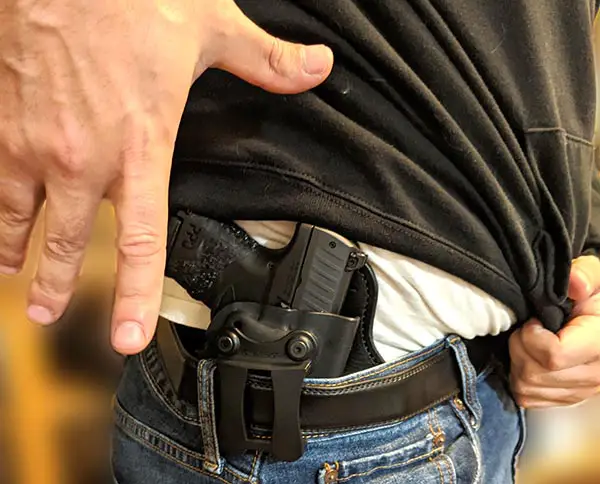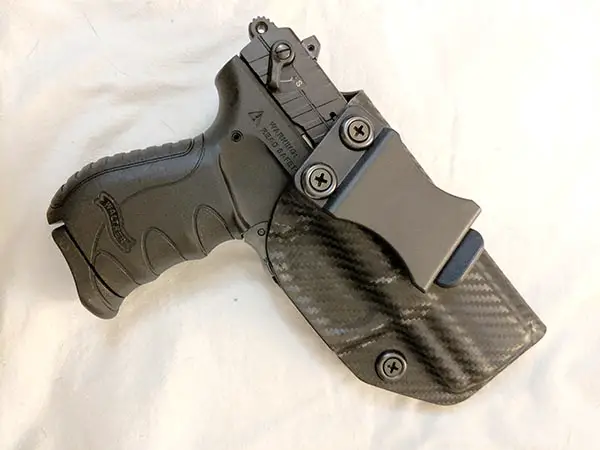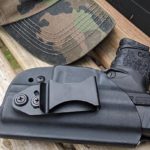Trying to figure out why that belt clip swivels, and how it should be set? Chances are that the adjustable clip is meant to modify the holster cant angle. Different holster platforms have different ways to change the angle of the holster shell. You may be wondering what I’m even talking about? Well today, I’m covering all things related to your holsters cant.
Table of Contents
What Is Holster Cant?

Holster cant is the angle at which the handgun shell is tilted relative to the primary orientation of the holster, either perpendicular or parallel to the ground. Fittingly, holster cant is measured in degrees. Additionally, cant angle is either negative, positive, or neutral.
Holsters worn on the waistband are measured differently than other types of holster. For IWB and OWB holsters the degree of tilt is relative to perpendicular. However, for holsters oriented in the horizontal position, such as shoulder holsters, cant is determined relative to parallel.
Neutral Cant Angle
Adjustable holsters direct from the manufacturer usually come with a neutral cant angle. Holsters worn on the hip have a neutral cant angle when the gun is directly perpendicular to the ground. However, shoulder holsters have a neutral cant angle when the gun sits parallel to the ground. When determining positive and negative cant angle, it is all in relation to the neutral cant angle of zero degrees.
Negative Holster Cant
Negative holster cant is when the bottom plate on the magazine moves closer to the floor. Therefore when an IWB/OWB holster is worn on the hip, the muzzle will point forward of the shooter. Certain concealed carry positions favor a negative cant. However, it would be difficult to draw your handgun in other concealed carry positions. More on this in the “Holster Position and Cant Angle” section.
Positive Holster Cant
Contrarily, positive holster cant angle places the magazine plate facing more upwards on waistband holsters. Generally, positive holster cant is best suited for concealed carry because a number of different positions favor this type of holster cant. Depending on where you prefer to carry your handgun, your cant angle will vary.
What Are The Different Holster Cant Angles?
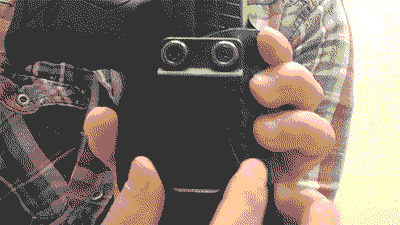
Now that we’ve discussed positive, negative, and neutral cant angles now we can talk about the varying degrees of holster cant. Usually, holsters cant angles will max at the -30 and +30 degrees. While there are a few options for extreme cant, those holsters are few and far between.
One such example of unlimited holster cant options is the Urban Carry Modular REVO (on Amazon). Although, the REVO does require you to purchase the shell separately. However, this does allow you to use the same setup for multiple handguns. If you want to know a bit more, you can read about my experience with this holster and the PPQ M2.
Holster Cant Chart
Below is a holster cant chart displaying what your holster might look like depending on the type of holster you have. It’s worth noting that I have never seen any adjustable holster with labeled cant angles. Therefore, I’ve only shown a few of the possible options between -30 and +30 degree cant.

What’s The Best Angle?
We’ve covered most of the basics about cant, and now you’re wondering how you should setup your holster. Finding the best holster cant will depend on your carry position. Determining the ideal cant angle comes down to what feels most natural and still safe when drawing your pistol. Usually, it’s easiest to draw from a canted holster where your wrist remains most neutral (i.e. not torqued in any one direction).
Finding the right cant angle will likely take some time drawing an unloaded handgun and multiple trips to the range, especially if you have different holsters for different guns. Should you change your shooting approach, you’ll need to re-evaluate what is the best holster cant.
Holster Position & Cant Angle
Your body naturally moves in certain patterns. Even if two people carry their concealed handgun in the same holster position, when they draw their handgun, their bodies move in different ways. Thus determining the exact holster angle depends largely on the individual.
However, there are general guidelines for concealed carry holster position. Below are generalizations and are not meant to be hard and fast rules. Experimenting on the range will help you find the ideal cant for your holster.
Hip Carry and Holster Cant
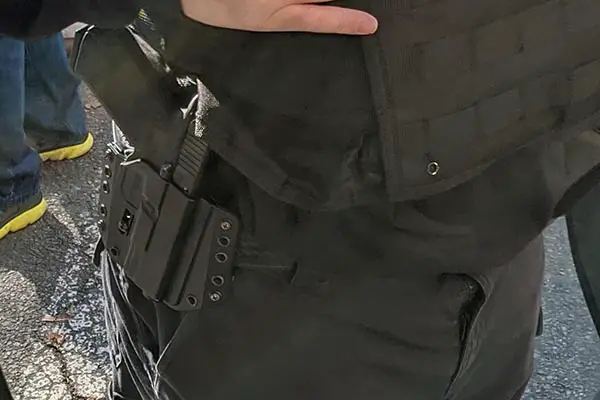
Carrying on your hip is a common practice for many in the concealed carry community. Generally, a positive or neutral cant allows for easy concealment without impeding the draw when a holster is worn on the hip. A negative cant angle could result in the handgun snagging on clothing when being drawn from concealment.
Appendix Carry & Holster Cant

If you opt to appendix carry, the best cant angle is going to be negative or neutral. What degree of cant will depend on ride height, body type, and ease of movement. Too much cant is cause for safety concern. Sometimes a positive cant can help prevent the appendix holster from digging into your body. However, many prefer the upright orientation of their handgun and opt for a neutral cant for safety reasons. Trying to use a positive cant means you’ll be removing the gun from the holster in the direction of your non-dominant hand.
3/4 & Behind The Back Carry
Before switching to appendix carry, this is my preferred method of carry when not carrying a concealed handgun at the office. Similar to carrying on your hip, a positively canted holster is going to be best to allow for a smooth draw. Unlike hip carry, even a neutral cant is going to be difficult to draw. For anyone with moderate flexibility, it will be next to impossible to draw with a negative cant and not feasible for self defense in my opinion.
Cross Draw Canting
Cross draw at the waistline is best achieved with a positive cant. Additionally, a greater angle is going to be best to more closely match the natural arm motion of reaching across your body. Muzzle direction and safety are a concern with this method of carry. Avoid using either a negative or even neutral holster cant as centering the firearm requires wasted motion.
Similarly, when using a shoulder holster, a slightly positive cant makes sense from an ergonomic perspective. The higher the cant angle, the lower the holster will need to sit on your side. A vertically oriented shoulder holster is more difficult to draw from, but has the added bonus of not sweeping/flagging anyone behind you with your muzzle.
How To Adjust Holster Cant Angle
Some holsters will provide multiple ways to manipulate the cant, while others do not offer any. Nowadays, it seems less common to find fixed holsters that don’t allow for canting at least the shell. One or more of the following options may be present on your holster for adjustment:
- Single clip that swivels
- Dual clip that controls ride height and cant
- Multiple belt loops
- Modular Velcro
- Adjustable straps (shoulder holsters)
Clips That Swivel

Single clip holsters are a popular option for IWB concealed carry. Either one or more screws control hold the holster clip in place and lock in your cant. Usually, the screws are either Flat head, Phillips head, or Allen key controlled.
Loosening the screws will allow the belt clip to move freely (usually within a designated channel). Be careful not to over tighten the screws as you could damage the shell. However, leaving the screw too loose can allow the clip to move while being worn. If you want to learn more about this type of holster, check out the analysis of my Concealment Express IWB holster.
Two Clip Holsters
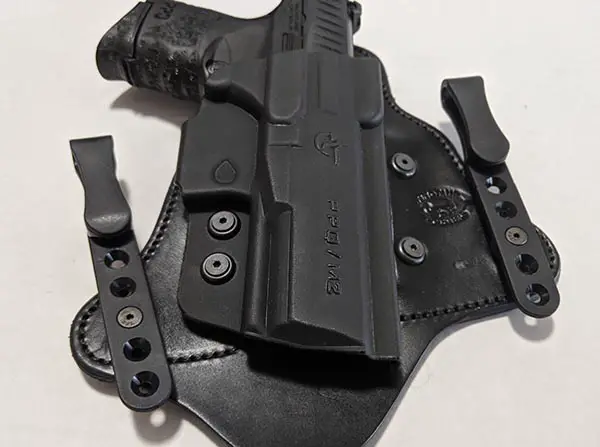
Another common waistband style holster involves dual belt clips. Holsters like this use the clips to control both the ride height and cant adjustment. Moving the forward clip lower, or the rear clip higher results in a positive cant. Contrarily, moving the clips in the opposite direction results in a negatively canted holster.
Some holsters like the one pictured above require basic tools to move the clips. Once you’ve removed the fasteners, move the holster clips in the desired direction to modify the cant. Reinstall the fastener and you’re done.
I highly recommend the Alien Gear Cloak Tuck for easy cant adjustment without tools. To modify your holster cant, simply rotate the clip 180 degrees. Pull the clip out of the holster and move it to another designated spot and twist back to the original position. This is great for on the spot adjustments.
OWB Holsters With Multiple Belt Loops
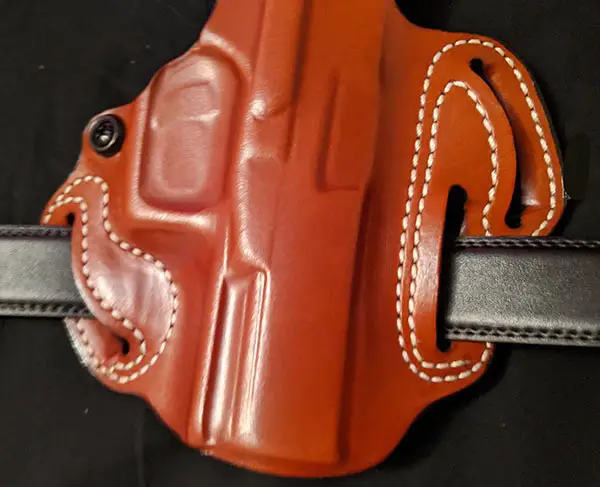
If you’re an OWB kind of person, you may be presented with a fixed holster that uses multiple belt loops to control the holster draw angle. This method is pretty straight forward and you simply need to thread your belt through an alternate belt loop. Generally the draw angle is fixed, so you won’t be able to fine tune your cant angle.
Modular With Velcro

A great example of this is the Urban Carry Modular REVO (on Amazon) holster I mentioned earlier. Pictured above is how that holster works, and allows for 360 degree adjustment. Although I’m not sure you’ll ever go past 180 in either direction, but to each their own. To adjust this, undo the snap buttons. Peel the holster from the velcro and afix at the appropriate angle. Redo the snaps and you’re done!
Adjusting Shoulder Holster Straps

Congrats on making it this far. We’re coming to the end of this guide to canted holsters. We’re finishing with the shoulder holster. Oftentimes, modifying the draw angle on these types of holsters is omitted. Generally, there are straps that can be loosened and tightened on a shoulder holster to allow the shell to be canted (see above). Raise the front of the holster, or lower the rear to created a positive cant angle.
Parting Shots
Whew! You made it to the end. Hopefully this article has shed some light on canted holsters and why this feature is available on many holsters on the market today. What do you think is the “best” holster cant? Leave a comment below, and be sure to share this article with others who might benefit.
